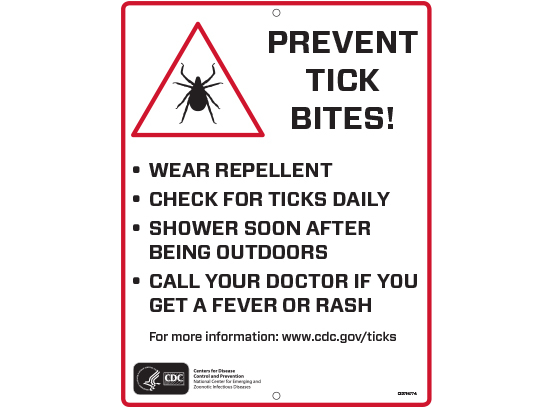Lyme Disease
Lyme Disease is a bacteria transmitted to humans by the bite of an infected Blacklegged tick (or deer tick). Symptoms may include headache, fever, and the characteristic "bulls-eye" skin rash (erythema migrans). If not treated, the infection can spread to joints, heart and nervous system. Lyme disease is diagnosed based on symptoms, physical findings (like the rash) and the possibility of exposure to ticks.

The best defense against Lyme disease and other tick-related infections is to reduce expose to ticks. The CDC recommends the following:
- Avoid wooded and brushy areas with high grass
- Walk in the center of trails
- Repel Ticks with DEET or Permethrin DEET
- Use repellents that contain 20 to 30% DEET (which also protects against mosquito bites) on exposed skin and clothing. Protection may last up to several hours. Parents should apply repellent on children (avoid hands, face and eyes).
- Use products that contain 0.5% Permethrin to treat clothing, gear (boots, socks, pants) and tents. It will remain protected through several washings. Pre-treated clothing is available at many camping/outdoor stores and may provide longer protection
- Take a shower or bath as soon as possible after coming indoors to wash off and find the ticks that may be crawling on you.
- Do a full-body tick check using a hand-held or full-length mirror to view all parts of your body after coming in from a tick-infested area.
- Check: underarms, in and around ears, inside the belly button, behind the knees, between the legs, around the waist and especially in the hair!
- Parents: check children in the above areas too!
- Examine gear and pets. Ticks can get a free ride home on these items and attach themselves to humans later. Examine everything!
- Put clothes in the dryer on HIGH heat for an hour to kill and possible ticks that you may have missed.
If you do find a tick attached to you, don't panic.
- Use tweezers to grab the tick as close to the skin as possible.
- Pull upward with steady, even pressure. Don't twist or jerk the tick, it can cause parts of the tick to break off and remain in the skin. (If it does remove what you can with tweezers, leave the remaining bits alone and let the skin heal.
- After removing the tick, thoroughly clean the bite area and your hands with alcohol or soap and water.
- Dispose of the tick by submersing it in alcohol, placing it in a sealed bag, wrapping it tightly in tape or flushing it down the toilet. Never crush a tick with your fingers.
- Hint: DON'T put nail polish, petroleum jelly or put a match to the tick to detach it from the skin!
Early signs and symptoms that usually occur within 3-30 days after a tick bite might include:
- Fever, chills, fatigue, muscle and joint aches, and swollen lymph nodes
- Bulls-eye (Erythema migrans) rash
- Occurs in approximately 70-80% of infected people
- Begins at the site of the tick bite
- Can expand over time to 12" or more
- May feel warm but is rarely itchy or painful.
Lyme disease diagnosis is based on signs and symptoms and history of possible exposure. You and your health care professional will decide how to proceed after discussing these circumstances. Should treatment be necessary, those receiving antibiotics in the early stages of Lyme disease usually recover quickly and completely.
MDH Clinician Letter for Tickborne Diseases (July 2021)
The CDC provides information and resources for clinicians and veterinarians about the diagnosis treatment and testing for not only humans, but for dogs and cats too.